Overcoming Limitations in Satellite Imagery: The Power of Intelligent Collection Planning
- Zuzana Hajkova, Content Marketing Coordinator, EUSI
Automated collection planning systems come with limitations. That’s why in European Space Imaging (EUSI), we combine autonomous planning software with expert human interventions to achieve higher quality of resulting images, as well as higher collection success rates under shorter time frames and unfavourable weather conditions. This system is called Intelligent Collection Planning. How does it work, and what benefits does it bring to our customers‘ projects?
Table of Contents
LIMITATIONS OF AUTOMATIC PLANNING SYSTEMS
Most satellite imagery providers rely on autonomous planning systems that come with several constraints. For instance, autonomous planning tools use weather forecasts to schedule image collections. However, while weather forecasting has improved over recent years, it is not always 100% accurate and cannot consistently predict the precise location, density, or timing of clouds. Unexpected, small-scale, or local weather events can disrupt planned collections, leading to missed opportunities or increased cloud coverage in the images.
Another drawback of automated planning systems can be the suboptimal quality of the resulting data. The software operates based on technical specifications, such as maximum permissible cloud coverage, and will plan an image collection which adheres to the specified limit. However, it won‘t always optimise the collections in the best interest of the customer. To illustrate this, let’s say the requirement is <15% cloud cover. If the cloud coverage in an image is 12%, the automatic system will assess the collection as meeting the requirement and schedule it – regardless of the possibility of achieving as little as 4% cloud coverage through an alternative collection approach.
The result can be suboptimal also because autonomous collection planning systems don’t take into account future considerations.
“They try to optimise each and every single satellite pass, which doesn’t always optimise resource allocation over various time periods and different sensors."
George Ellis, Vice President of Operations at EUSI
For instance, automated tools may schedule collections based on current priorities without adjusting for mid-term weather or future satellite passes, potentially resulting in less efficient resource allocation. More effective results are typically achieved through strategic long-term collection planning instead.
To summarize:
- Automated systems may struggle to adapt when the real-time weather deviates from forecasts.
- Adhering to technical specifications can result in suboptimal data quality, as the collections are not always optimised in the customer‘s best interest.
- Autonomous planning systems overlook future factors, which may lead to inefficient resource allocation.
OVERCOMING LIMITATIONS THANKS TO INTELLIGENT COLLECTION PLANNING
In order to eliminate the downsides of autonomous planning systems, we have introduced Intelligent Collection Planning (ICP), a solution that combines advanced planning software with expert human interventions. The automated system presents to an expert (Collection Planner), who reviews them every 15 minutes and makes various adjustments to optimise them. That results in:
- up to 20% higher efficiency
- increased achievable collection area
- faster collection of the target
- successful completion even under difficult weather conditions
- alignment with, or exceeding, the customer’s technical requirements
- reduced cloud coverage
- minimal sun glint
- adherence to budget constraints
- higher data homogeneity
How exactly do the Collection Planners achieve this? The four main pillars of Intelligent Collection Planning are utilizing real-time weather data, optimising collection system plans, smart recollection, and sun glint reduction.
1. “SHOOTING AROUND CLOUDS” WITH REAL-TIME WEATHER DATA
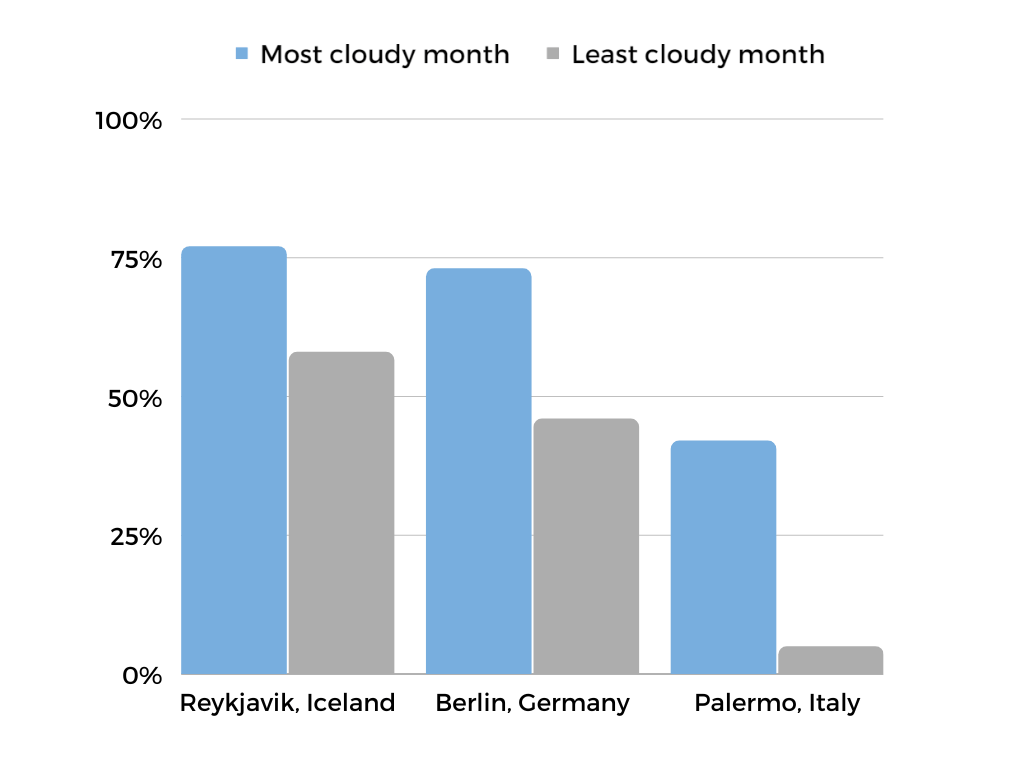
Percentage of the time when cloud cover is 60% or higher
To overcome this challenge, it is crucial that Collection Planners work with real-time weather data and constantly optimise collections for lower cloud cover. They combine forecasts with their own evaluation based on real-time data from weather satellites, with real-time weather being the primary decision driver in the majority of cases.
The collection plan is finalized between 30 minutes and 1 minute prior to contact with the satellite, meaning that the weather data is as fresh as possible, and changes in meteorological conditions have only minimal impact on the quality of the imagery. What difference does a few percent make? See for yourself: In the images below, you can compare the same area with different levels of cloud cover.
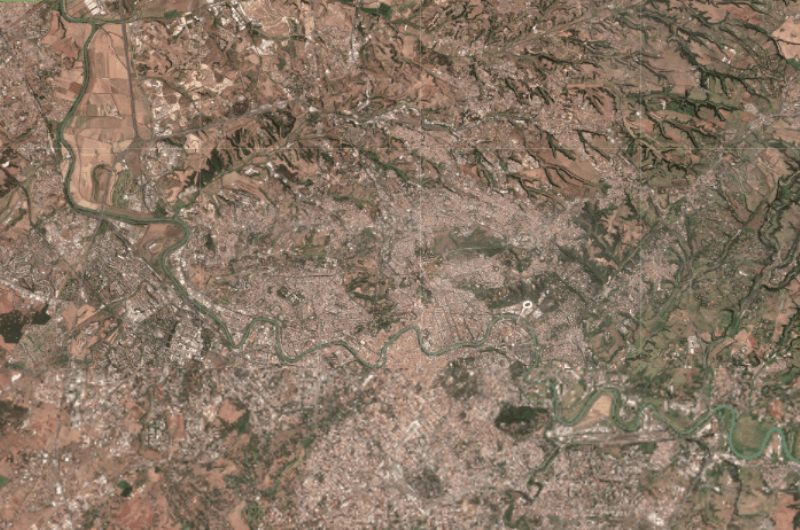
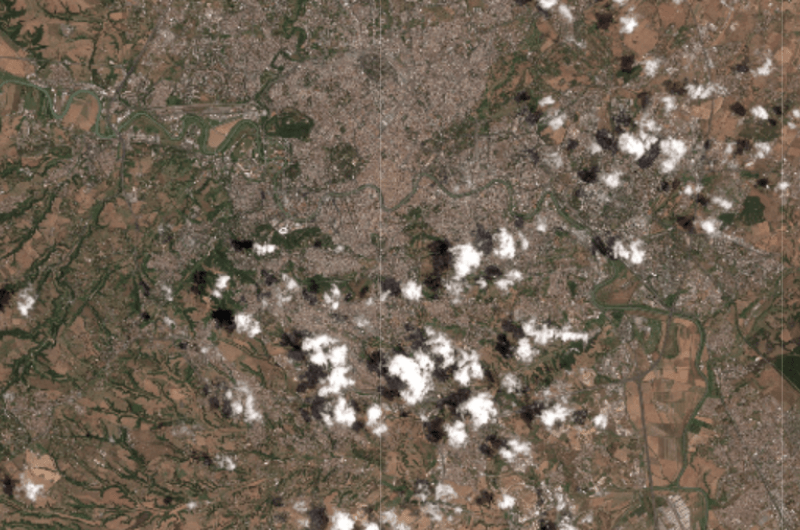
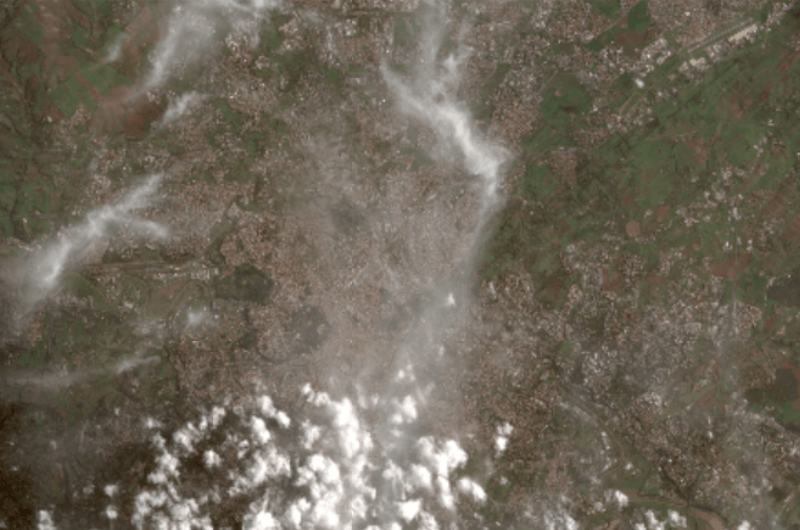
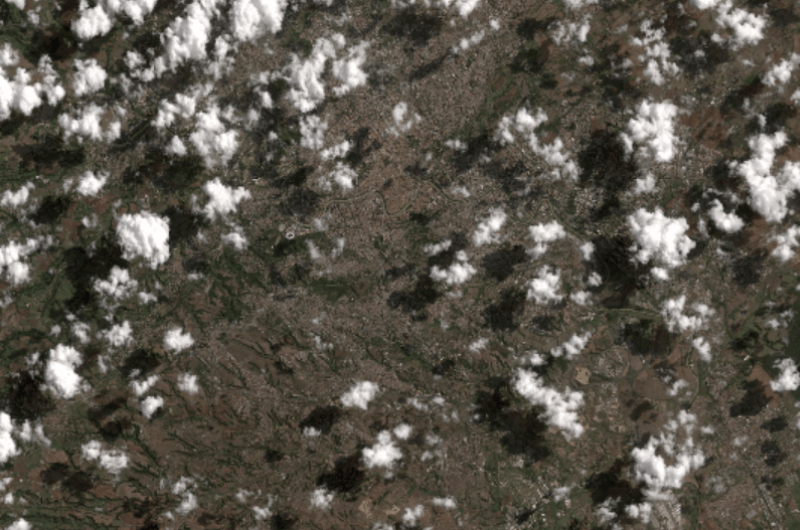
2. OPTIMISING COLLECTION PLANS
To achieve optimal collections, we combine different satellite sensors, consider current and future satellite access, and apply information about real-time weather as well as weather forecasts. Based on all these data, we edit the software-suggested imaging plan. Optimising the collections leads to faster and more efficient collections and higher quality of the resulting data.
Imagine the following scenario: Your area of interest (AOI) is a slightly tilted rectangle like in the picture below. The collection planning system splits it in five scans in the north-south direction with ample overlap between the scans and suggests collecting two on any given pass. Therefore, you collect two stripes today and the rest on another day. But what if today is the last day with good weather for the next several weeks, and therefore you need to complete the area today? Or what if you want to collect the whole area in one day to ensure higher homogeneity of the data? Automated systems usually don’t take this into account.
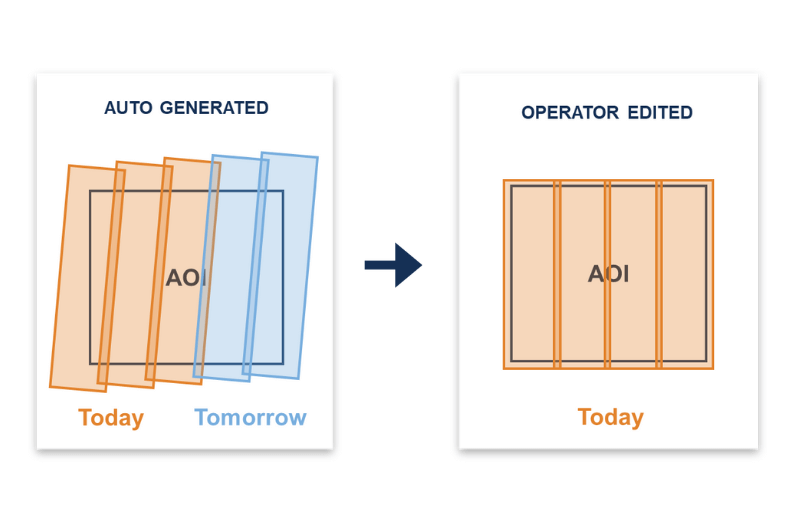
Optimising collection plan
This is why expert Collection Planners optimise the suggested plan. In this particular example, they can delete the redundant scans by eliminating too conservative overlaps, and then tilt and shift the remaining scans to better cover the AOI and minimise the slew times of the sensor. If there are other targets in the region which have a lower priority or are more flexible in terms of the collection date, the Collection Planners can decide to dedicate more imaging time to the more demanding area. As a result, the AOI will be collected in one pass on one day instead of two or three passes over multiple days or even weeks.
3. SMART RECOLLECTION
Smart recollection means that we collect two or more images with a tailored overlap, leading to a higher quality of the resulting image. As an illustration, see the following real-life use case from a collection in Iceland:
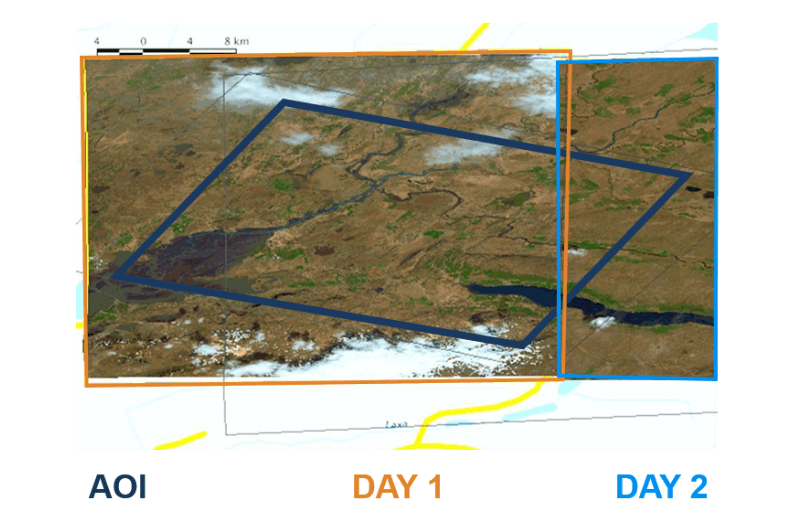
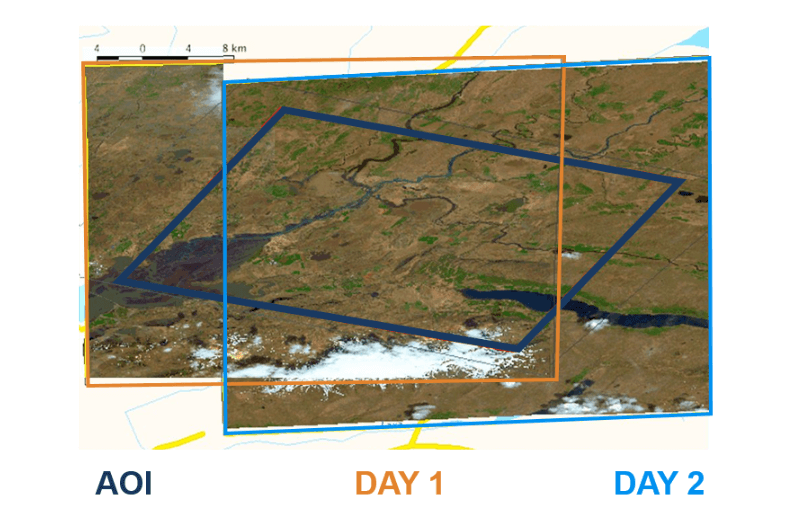
Because of the specific pass geometry, an automated system suggested collecting the target area (dark blue in the picture above) in two days. The eastern image would be collected on day one (orange), having cloud cover of 7% which meets the criteria specified by the customer. As this image fulfills the requirements, the system would consider it successful and collect only the small remaining area to the West on day two (light blue). The combined images over the AOI would have approximately 7% cloud cover.
However, the Collection Planner adjusted the plan. They carried out the first suggestion on day one as the software suggested (orange) but on day two, the weather conditions improved. Therefore, the Planner collected the second image with a huge overlap (light blue) and hence “eliminated” the clouds from the previous day. The resulting combined image had a 2% cloud cover.
“This leads to the surprising fact that on the same days, over the same area, using the same sensor, you can get two very different end results. The customer would have had to accept 7% cloud cover, but 2% cloud cover exceeded their expectations and provided better insights for their project.”
George Ellis, Vice President of Operations at EUSI
4. REDUCING SUN GLINT
Sun glint occurs when sunlight reflects off water, snow, metal roofs, solar panels, greenhouses, or any other reflective surfaces at the satellite, over-saturating the imaging sensor and causing blurry streaks of bright white patches in the image. The reflection can vary in intensity, depending on the angle of the sun, the viewing angle of the satellite, or the roughness of the surface.
Sun glint can make it impossible to extract useful information from satellite imagery. To minimise the impact on image quality, we follow a specific procedure. If a collection is planned over a sun glint region, the newest version of our planning software automatically changes the collection plan so that the looking direction of the satellite to the area of interest doesn’t point to a region where sun glint may occur. By further adjusting the timing and angle of the imaging manually, we are able to deliver high-quality data with a minimum impact of sun glint that meets even the strictest technical requirements.
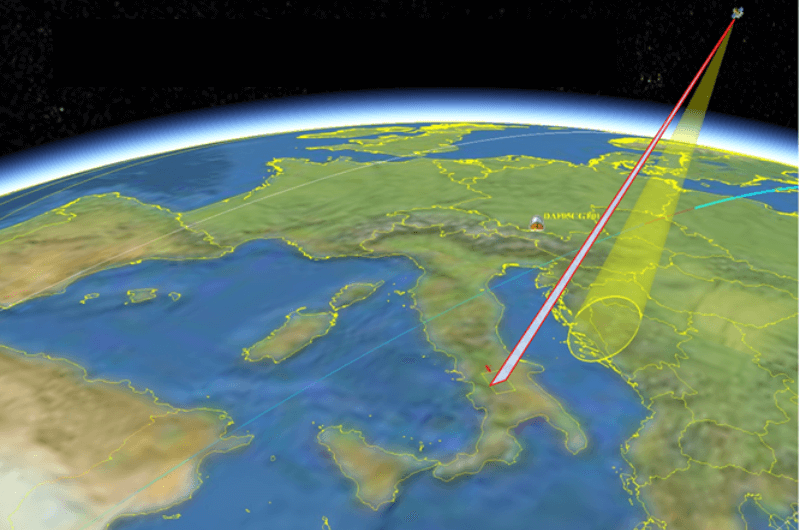
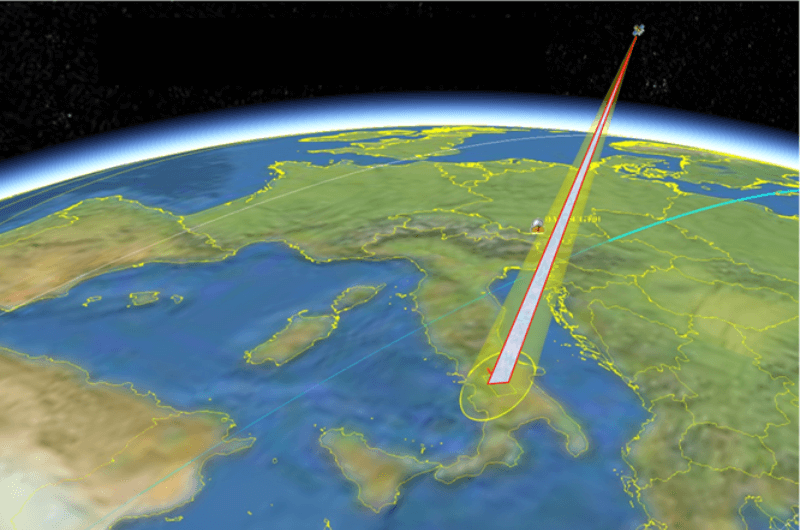
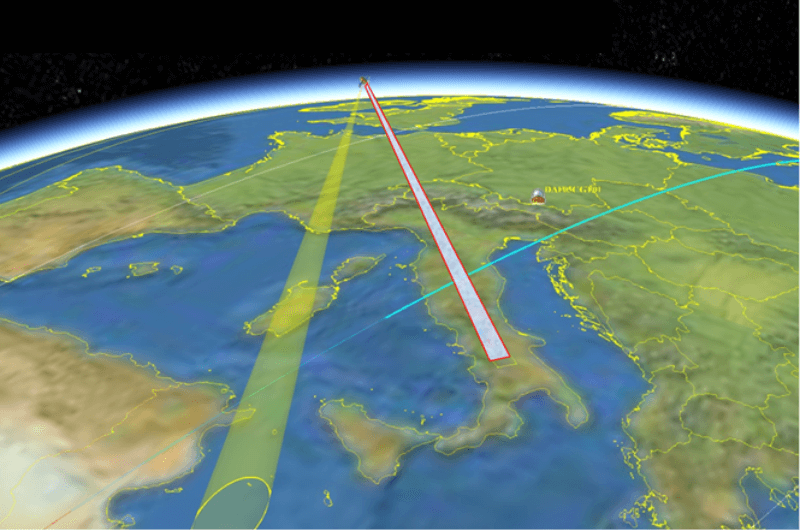
As the satellite is moving in its orbit, so does the sun glint reflection area in respect to the satellite. We start scanning outside of sun glint area (image 1). Once the sun glint reaches the AOI where we are scanning, we interrupt the scan for 10–15 seconds (image 2), and once the sun glint area has moved further from the target, we continue scanning (image 3).
It is important to mention that while this approach is very effective, it cannot eliminate 100% of all sun glint. We are able to avoid reflections from flat surfaces like water bodies or flat rooftops, however, there may still be occasional sun glint for example from tilted roofs or wave action over water. However, this type of sun glint is minimal, compared to looking straight into a sun glint area.
INTELLIGENT COLLECTION PLANNING ON A TIMELINE
How do we apply Intelligent Collection Planning to a project? It all starts with a feasibility study. Once approved, the project is set into motion, with a dedicated team monitoring progress. Three days ahead of the satellite pass, resources are allocated, followed by a pre-collection analysis one day before the pass. The Collection Planner finalises the final plan 15 minutes before the satellite contact, and reviews the results immediately after the collection.
FEASIBILITY STUDY
Before collection planning for larger areas, we always carry out the feasibility study and verify it with the customer. The study consists of several steps:
First, we split the target area into individual collection units. Subsequently, we apply satellite capacity to the segments, which gives us information about how often a certain sensor flies over the target and how much can be collected per satellite pass. This calculation summarizes how quickly the area can be collected, so far disregarding any weather influence. For example in Greece, the time needed for collection, in the case of perfect weather, would be around 3 weeks.
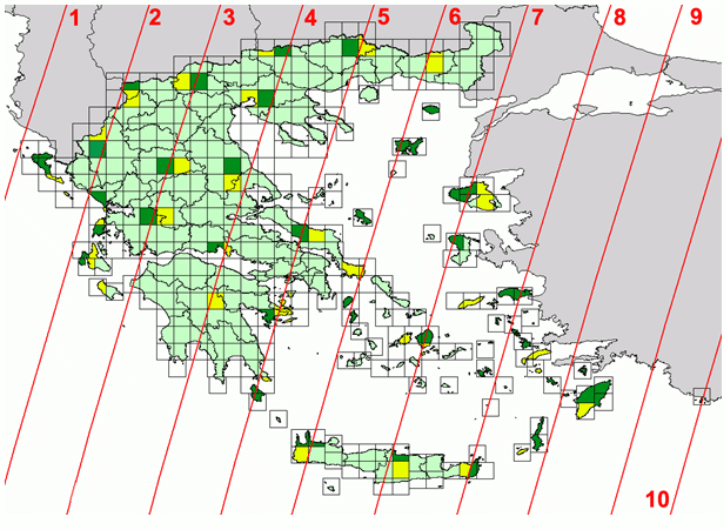
Greece split into smaller segments for satellite imagery collection
In the next step, information about statistical weather is added to the calculation, and Collection Planners apply sophisticated mathematical formulas to create the prediction of the collection progress. This prediction is then discussed with the customer.
COLLECTION PROJECT
Once the customer agrees and the project starts, a dedicated collection team starts closely monitoring the collection progress. After each pass, they review the collection and if needed, immediately adjust the remaining areas of interest to optimise the available satellite capacity and ensure successful completion. In most cases, the progress of the collection closely matches the prediction.
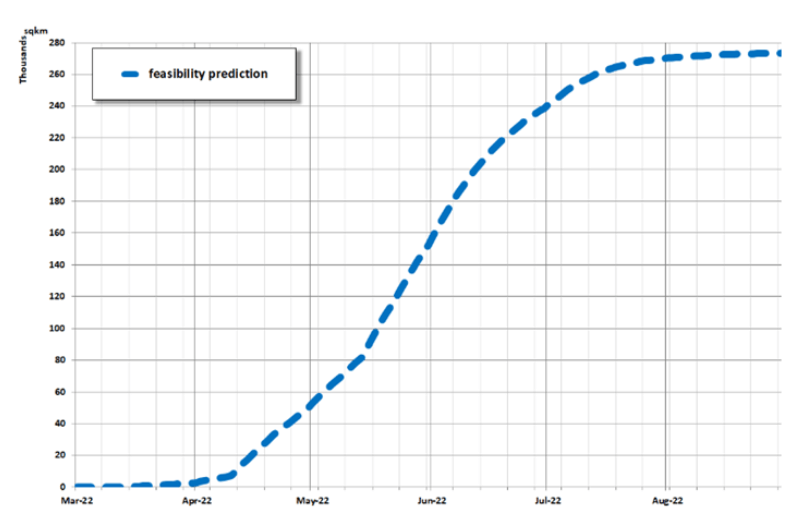
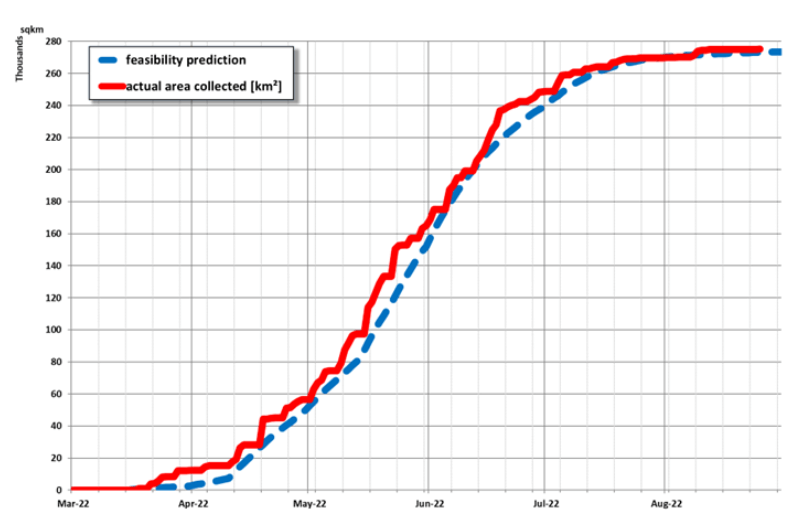
Prediction of the collection progress over the project area (blue) and the actual progress (red)
72–24 HOURS BEFORE THE PASS: RESOURCE DISTRIBUTION
Between three and one day prior to the satellite pass, we initiate resource distribution. This involves the selection of satellites best fitting the collection requirements, and systematic allocation of specific sensors to the projects. The satellites we operate are:
ONE DAY BEFORE THE PASS: ANALYSIS PASS
One day in advance, we conduct analysis passes, which are simulated run-throughs of the planned collections within our collection planning system. This preparatory step allows us to address potential issues, verify customer’s priorities, and consider forecasted weather. As a result, we are well-prepared to evaluate and implement the best strategies during the actual pass.
ONE DAY BEFORE THE PASS: ANALYSIS PASS
One day in advance, we conduct analysis passes, which are simulated run-throughs of the planned collections within our collection planning system. This preparatory step allows us to address potential issues, verify customer’s priorities, and consider forecasted weather. As a result, we are well-prepared to evaluate and implement the best strategies during the actual pass.
HOURS AND MINUTES BEFORE THE PASS: DETAILED PASS PLANNING
Starting 3 hours up to 15 minutes before the contact, we optimise the plan. This process involves:
- the manual adjustment of scan directions
- the realignment of scans
- an evaluation of the latest order priorities
- temporary suspensions of lower-priority orders
- the consolidation of orders that may be of collective interest in nearby regions
- an assessment of future collection opportunities
Every 15 minutes, we incorporate real-time weather data, and if unexpected opportunities or constraints arise, we contact the customer to reaffirm priorities.
AFTER THE PASS: DETAILED REVIEW
Following each pass and collection of satellite images, we conduct a detailed review of the results and make immediate adjustments to the areas of interest.
FLEXIBILITY LEADS TO HIGHER SUCCESS RATES
In 20 years of tasking satellites with a local ground station near Munich, we have seen that the success of Intelligent Collection Planning lies both in human expertise and great flexibility. Applying real-time weather data, minimising the number of images to fulfill an order, integration of last-minute order requests, and considering customer priorities on short notice allow us to deliver significantly better results compared to systems that use only the automatic centralized planning tool.
Thanks to Intelligent Collection Planning, we are able to consistently complete successful collections of satellite imagery with:
- near-real-time delivery up to 15 minutes after collection
- guaranteed cloud cover under 15%
- 8 multispectral bands, 30 hyperspectral bands and 8 SWIR bands
- resolution of up to 30 cm
- enhanced resolution of 15 cm
Do you want to learn more? Do you have any questions about Intelligent Collection Planning or Very-High-Resolution satellite imagery? Contact us. No matter what, our experts are ready to help.
1 https://weatherspark.com/countries/DE
Related Stories

GEOSeries: Extracting Insights From High Resolution SAR Imagery for Time-Sensitive Analysis
In this webinar, industry experts and advanced users of Umbra SAR data showcase how they transform SAR imagery into actionable insights in real-world mapping, monitoring and intelligence applications. See how NV5 and Umbra leverage ENVI SAR Essentials for advanced processing with time-efficient results, converting analytics into valuable intelligence.

Using Satellite Imagery to Build Water Resilience Across Europe
Water across Europe is facing severe pressure. Climate change, urbanisation, agricultural demands and other sources of pollution are threatening water security and creating critical challenges that need to be addressed. We have to act quickly, build stronger systems and create sustainable water resilience practices – so that both natural ecosystems and human communities can thrive. Here is how satellite imagery from EUSI can help.

EUSI and Albedo Partner to Deliver 10 cm Resolution Satellite Imagery to Europe
It is our pleasure to announce the partnership with Albedo, a builder of high-performance spacecraft and the first satellite designed to operate commercially in VLEO (Very Low Earth Orbit). This partnership will bring the world’s highest resolution satellite imagery to the European and North African market.

Updating the Land Parcel Identification Systems in 2025: The Benefits of Using Satellite Images
Agricultural paying agencies across Europe face increasing challenges in maintaining accurate and up-to-date Land Parcel Identification Systems (LPIS), ensuring compliance with the Common Agricultural Policy (CAP) and supporting sustainable agricultural practices.





